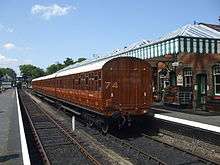Coaches of the London and North Eastern Railway
The London and North Eastern Railway (LNER) inherited several styles of coaching stock from its constituents. Sir Nigel Gresley continued the styles that he had established pre-grouping at the Great Northern Railway (GNR) and for the East Coast Joint Stock.
Coaches inherited from pre-grouping companies
Various types of coaches were inherited from pre-grouping companies.
Ex-Great North of Scotland Railway
Two GNSR six-wheel coaches of c.1896 are preserved on the Strathspey Railway. The GNSR Royal Saloon of 1898 is preserved by the Scottish Railway Preservation Society[1] at Bo'ness.
Ex-East Coast Joint Stock
A number of these vehicles remain extant on various heritage railways including the NYMR and the Embsay and Bolton Abbey Steam Railway in addition to the NRM, some being over 100 years old.
Ex-Great Northern Railway
Amongst other GNR coaches elsewhere Corridor Composite 2701 is fully restored and operational on the Severn Valley Railway. After withdrawal from main line service it was converted to Camp Coach 157 and located at Mundesley, Norfolk.
Great Northern Railway Lavatory Composite Brake No. 2856 is with the Vintage Carriage Trust at Ingrow on the Keighley and Worth Valley Railway.
Coaches built by the LNER
Quadart stock

Gresley first introduced articulation in passenger stock in 1907 using converted vehicles, but in 1911 he produced some articulated suburban stock for the GNR. These were articulated pairs and were later rebuilt as four-coach ('Quadart') units. From 1921–9 further 'Quadart' compartment stock was built with an eventual total of 97 GNR and LNER sets.
Two 'Quadarts' formed an eight-coach train. Because of their high seating capacity they were popular with the operators and some continued in traffic until April 1966. One set is preserved by the Midland and Great Northern Joint Railway Society at the North Norfolk Railway.[1]
Standard corridor stock
The standard LNER corridor coach design was finalised in 1923, using a 60 ft underframe, though some for use on the Great Eastern were on 51 ft underframes. The LNER standard coach was in advance of those of the other three of the Big Four by virtue of the Pullman gangways and buckeye couplers. The wooden teak-panelled body with squared mouldings and windows was more traditional than modern, particularly as the LNER persisted with this construction until 1942. In fact, there were few differences in design over the 1923-42 period, apart from an increase in body width to 9 ft 3in after 1927. All these standard coaches were mounted on Gresley double-bolster 8 ft 6in bogies. The general service stock was withdrawn by 1965. Several examples are preserved.
Observation saloons
In 1937, the LNER built two observation coaches at Doncaster Works for use on The Coronation express passenger train during the summer months. Looking quite different to the teak coaches, they in many respects resembled the LNER Class A4 locomotives that hauled the train. The carriages had a conventional corridor connection at one end and a deeply glazed tapered end at the other, so many enthusiast referred to them as Beavertails. Both were fitted out with Art-deco styling and a luxury bar/lounge combination.
During the Second World War both were put in store and, in 1959, E1719E was rebuilt by British Railways with larger panoramic windows for West Highland Line specials. The other coach, numbered E1729E, went into a long period of storage at Steamtown, Carnforth. Both coaches survive today in the hands of Railway Vehicle Preservations Ltd on the preserved Great Central Railway, Loughborough, where they allow first class ticket holders to travel in restored E1719E. After many negotiations E1729E is now at Nemesis Rail, undergoing restoration into its as-built condition.
Pigeon vans
Pigeon vans (British Rail TOPS classification: BGP) were fairly common rail vehicles on the LNER, which built dozens in the late 1930s and early 1940s. Although designed for transporting racing pigeons to release locations, with very little modification they could also carry mail or other freight. The first batch was made of teak wood, treated with varnish, but the economic climate of World War II meant that many batches were built with steel bodies to the same basic design.
Preservation
One steel-built pigeon van has been preserved, as have 14 of the teak coaches.5 pigeon vans have been restored and are used on heritage railways as guard's vans on passenger trains and mail drop recreations.
The Severn Valley Railway has 7 LNER teak coaches including Buffet No. 643, Kitchen Composite No. 7960, Open Thirds Nos, 24105, 43600, 43612, 52250 along with former pre-grouping GNR composite No. 2701.
The North Yorkshire Moors Railway also has 11 coaches originating from the LNER and its constituents including ECJS 189 dating from 1896. This vehicle is being restored at Pickering to its former glory, by the LNER Coach Association (Registered Charity no.1095337) in its later modified form, as a sumptuous 33 seat third class diner having originally been built as a 42-seat vehicle.
In total 38 LNER Teak Coaches have been preserved.
References
Bibliography
- Harris, Michael (1976). Preserved Railway Coaches. Shepperton: Ian Allan Ltd. ISBN 0-7110-0664-4.
Further reading
- Harris, Michael (1995). LNER Carriages. Penryn: Atlantic Books. ISBN 0-906899-47-8.
External links
- LNER carriages preserved on the Severn Valley Railway
- 1936 Gresley-designed LNER Kitchen Composite 7960 (preserved) – history and restoration
- LNER carriages preserved by the LNER Coach Association on the North Yorkshire Moors Railway